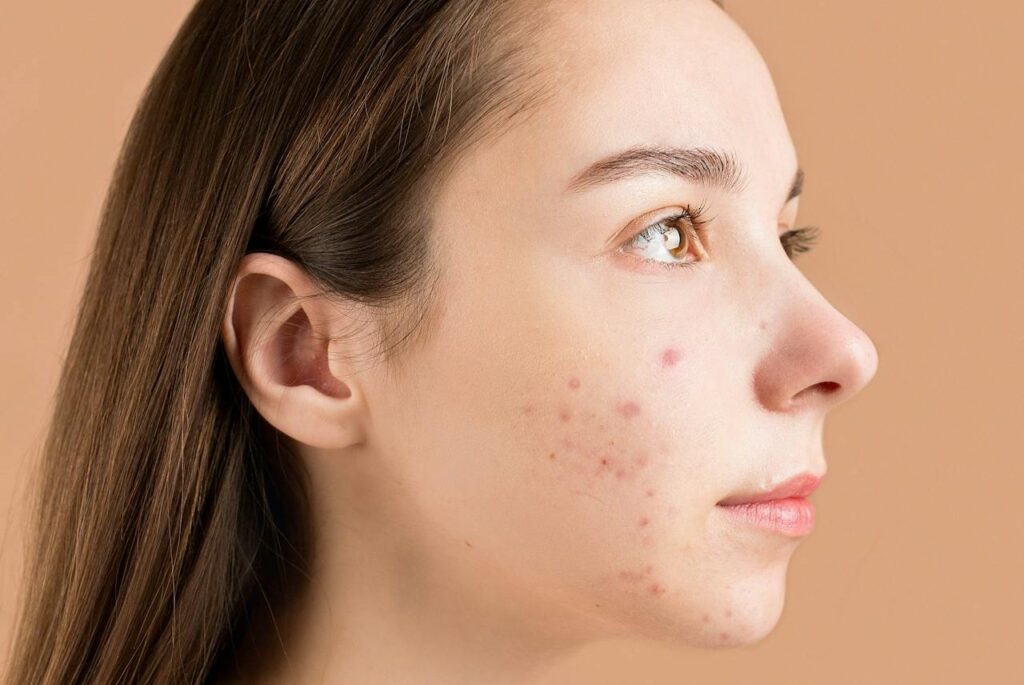Acne affects nearly 85% of people between ages 12 and 24, making it one of the most common skin conditions worldwide. While dealing with breakouts can feel overwhelming, dermatologists have developed highly effective treatment strategies for every type of acne. Understanding your specific acne type and choosing the right treatment approach can lead to clearer skin and improved confidence.
Understanding Different Types of Acne
Non-Inflammatory Acne
Blackheads (Open Comedones)
Blackheads form when pores become clogged with excess sebum and dead skin cells. The dark appearance isn’t dirt—it’s oxidized melanin exposed to air. These typically appear on the nose, chin, and forehead where oil production is highest.
Whiteheads (Closed Comedones)
Whiteheads occur when clogged pores remain closed beneath the skin surface. They appear as small, flesh-colored or white bumps and are often found on the face, chest, and back.
Inflammatory Acne
Papules
These small, red, tender bumps develop when bacteria (primarily Cutibacterium acnes) infect clogged pores, causing inflammation. Papules don’t contain visible pus and should never be squeezed.
Pustules
Similar to papules but filled with white or yellow pus, pustules are the classic “pimple” most people recognize. They have a red base with a white or yellow center.
Nodules
Large, painful lumps that develop deep within the skin, nodules are solid and can persist for weeks or months. They’re more likely to cause scarring than surface-level acne.
Cysts
The most severe form of acne, cysts are large, pus-filled lesions that extend deep into the skin. They’re extremely painful and almost always require professional treatment to prevent permanent scarring.
Over-the-Counter Treatment Solutions
Topical Retinoids
Adapalene (Differin)
The only over-the-counter retinoid available, adapalene is highly effective for both blackheads and whiteheads. It works by normalizing skin cell turnover and preventing pore blockages.
- Start with every other night application
- Use a pea-sized amount for the entire face
- Always apply sunscreen during the day
- Results typically appear after 6-8 weeks
Benzoyl Peroxide
This powerful antibacterial agent kills acne-causing bacteria and helps unclog pores. Available in concentrations from 2.5% to 10%, it’s particularly effective for inflammatory acne.
Application Tips:
- Begin with 2.5% concentration to minimize irritation
- Apply to clean, dry skin
- Can bleach fabrics, so use white towels and pillowcases
- Combine with moisturizer to prevent excessive dryness
Salicylic Acid
A beta-hydroxy acid that penetrates oil-filled pores, salicylic acid is excellent for blackheads and whiteheads. It’s gentler than benzoyl peroxide and suitable for sensitive skin.
Best Practices:
- Use 0.5% to 2% concentrations
- Apply once or twice daily
- Ideal for maintenance therapy
- Works well in combination with other treatments
Prescription Treatment Options
Topical Prescription Medications
Tretinoin (Retin-A)
The gold standard of acne treatment, tretinoin is more potent than over-the-counter retinoids. It’s particularly effective for comedonal acne and helps prevent new breakouts.
Topical Antibiotics
Clindamycin and erythromycin reduce bacteria and inflammation. They’re often combined with benzoyl peroxide to prevent antibiotic resistance.
Azelaic Acid
This naturally occurring acid has antibacterial and anti-inflammatory properties. It’s particularly beneficial for people with darker skin tones as it can help fade post-inflammatory hyperpigmentation.
Oral Medications
Antibiotics
For moderate to severe inflammatory acne, oral antibiotics like doxycycline, minocycline, and tetracycline reduce bacteria and inflammation.
Duration and Considerations:
- Typically prescribed for 3-6 months
- Should be combined with topical treatments
- May cause sun sensitivity
- Probiotics can help maintain gut health
Hormonal Therapies
For women with hormonal acne, birth control pills containing estrogen and progestin can significantly reduce breakouts. Spironolactone, an anti-androgen medication, is another effective option.
Isotretinoin (Accutane)
Reserved for severe, cystic acne that doesn’t respond to other treatments, isotretinoin is highly effective but requires careful monitoring due to potential side effects.
Professional Dermatological Procedures
Chemical Peels
Dermatologists use various acids (glycolic, salicylic, or trichloroacetic acid) to remove damaged skin layers and unclog pores. Light peels can be done monthly, while deeper peels require longer recovery periods.
Light and Laser Therapy
Blue Light Therapy
Targets acne-causing bacteria without damaging surrounding skin. Typically requires multiple sessions for optimal results.
Photodynamic Therapy (PDT)
Combines light therapy with a photosensitizing agent to destroy bacteria and reduce oil production.
Corticosteroid Injections
For large, painful cysts or nodules, dermatologists can inject corticosteroids directly into the lesion, reducing inflammation and preventing scarring within 24-48 hours.
Professional Extractions
Dermatologists can safely remove stubborn blackheads and whiteheads using specialized tools, preventing the scarring that often results from at-home extraction attempts.
Treatment Strategies for Different Skin Types and Ages
Acne in Different Skin Tones
People with darker skin tones are more prone to post-inflammatory hyperpigmentation (PIH). Treatment considerations include:
- Gentler exfoliation to prevent irritation
- Incorporating ingredients like vitamin C, kojic acid, and hydroquinone
- Avoiding aggressive treatments that can worsen PIH
- Using broad-spectrum sunscreen daily
Teenage Acne
Adolescent acne is primarily hormonal and often responds well to:
- Consistent skincare routine with gentle cleansers
- Over-the-counter retinoids and benzoyl peroxide
- Professional guidance for moderate to severe cases
- Education about proper skincare habits
Adult Acne
Adult acne, particularly in women, often has hormonal components and may require:
- Hormonal therapies like spironolactone or birth control
- Stress management techniques
- Evaluation of skincare and makeup products
- Assessment of dietary triggers
Comprehensive Skincare Routine Integration
Morning Routine
- Gentle cleanser
- Topical treatment (if prescribed for morning use)
- Moisturizer with hyaluronic acid or ceramides
- Broad-spectrum SPF 30+ sunscreen
Evening Routine
- Double cleanse (oil cleanser followed by water-based cleanser)
- Wait 20-30 minutes after cleansing
- Apply retinoid or other prescribed treatment
- Moisturizer to prevent dryness and irritation
Weekly Additions
- Gentle exfoliation 1-2 times per week
- Clay masks for oily areas
- Hydrating masks for dry or irritated skin
Lifestyle Factors and Prevention
Dietary Considerations
While the relationship between diet and acne is complex, some evidence suggests:
- High-glycemic foods may worsen acne in some individuals
- Dairy products might trigger breakouts in sensitive people
- Omega-3 fatty acids may have anti-inflammatory benefits
- Staying hydrated supports overall skin health
Stress Management
Chronic stress increases cortisol production, which can worsen acne. Effective stress management includes:
- Regular exercise
- Adequate sleep (7-9 hours nightly)
- Meditation or mindfulness practices
- Professional counseling when needed
Environmental Factors
- Change pillowcases frequently
- Clean phones and other items that touch your face
- Avoid touching or picking at your skin
- Choose non-comedogenic makeup and skincare products
When to See a Dermatologist
Seek professional help if you experience:
- Cystic or nodular acne
- Acne that doesn’t respond to over-the-counter treatments after 6-8 weeks
- Signs of scarring or post-inflammatory hyperpigmentation
- Emotional distress related to your acne
- Sudden onset of severe acne in adults
Cost Considerations and Insurance Coverage
Many insurance plans cover dermatological acne treatments, including:
- Office visits and consultations
- Prescription medications
- Some professional procedures
Generic versions of many acne medications are available, making treatment more affordable. Patient assistance programs may help with expensive medications like isotretinoin.
Post-Acne Care and Maintenance
Once acne is under control, maintaining clear skin requires:
- Continued use of proven treatments at reduced frequency
- Regular dermatological check-ups
- Consistent skincare routine
- Prompt treatment of new breakouts
- Scar treatment if needed (laser therapy, microneedling, chemical peels)
Frequently Asked Questions
How long does it take to see results from acne treatment?
Most treatments require 6-8 weeks to show significant improvement. Some people may see initial results in 2-4 weeks, while others need 12 weeks or more for optimal results.
Can I use multiple acne treatments at once?
Yes, but introduce new products gradually to avoid irritation. Many dermatologists recommend combining treatments like retinoids with benzoyl peroxide or antibiotics for enhanced effectiveness.
Will my acne come back if I stop treatment?
Acne is a chronic condition that often requires ongoing maintenance therapy. Stopping treatment typically leads to the return of breakouts, though some people may need less intensive treatment over time.
Is it normal for acne to get worse before it gets better?
Yes, this is called “purging” and commonly occurs with retinoids and other treatments that increase cell turnover. This temporary worsening usually lasts 4-6 weeks.
Can adults develop acne for the first time?
Absolutely. Adult-onset acne is increasingly common, particularly in women, and often has different causes than teenage acne, including hormonal changes, stress, and certain products.
Take Action for Clearer Skin
Effective acne treatment is available for everyone, regardless of age, skin type, or acne severity. The key is finding the right combination of treatments for your specific needs and maintaining consistency with your routine.
Start with a gentle approach using over-the-counter options, and don’t hesitate to consult a dermatologist if you’re not seeing results or dealing with severe acne. Remember that clear skin is achievable with the right treatment plan, patience, and professional guidance when needed.
Your journey to clearer skin starts with understanding your acne type and choosing evidence-based treatments. With today’s advanced treatment options and personalized care approaches, you can achieve the healthy, clear skin you deserve.



